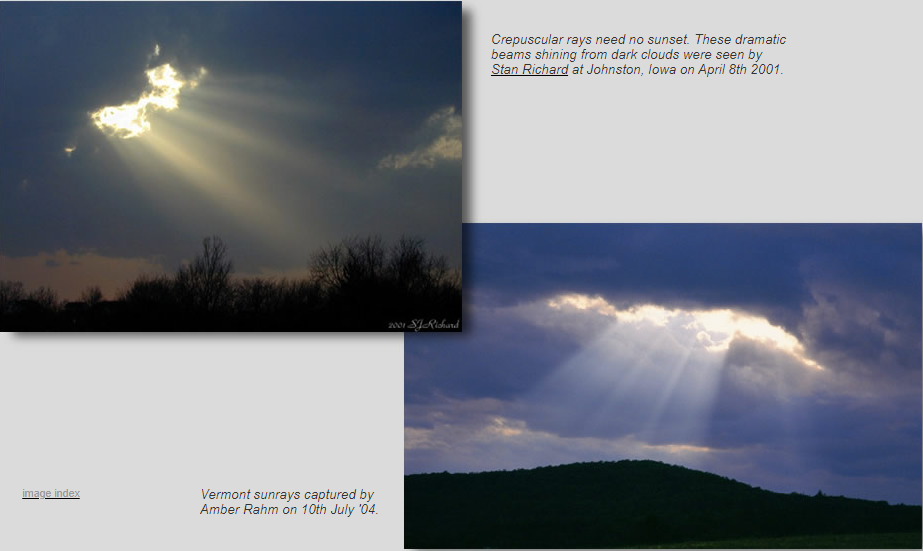Crepuscular rays - Beams of light
Crepuscular Rays: Beams of Light Illuminating the Sky
Crepuscular rays, also known as sunrays or God rays, are a mesmerizing atmospheric optical phenomenon that captivates viewers around the world. These awe-inspiring beams of light seemingly radiate from a central point in the sky, creating a stunning display of celestial beauty. While commonly associated with sunsets, crepuscular rays can actually occur at any time of the day, provided the conditions are right.
The Science Behind Crepuscular Rays
Crepuscular rays are formed when sunlight interacts with particles in the Earth's atmosphere, such as dust, water droplets, or smoke. As sunlight travels through the atmosphere, it encounters these particles, which scatter and absorb light. The scattered light then becomes visible to the human eye, creating the illusion of radiant beams stretching across the sky.
Atmospheric Conditions and Formation
For crepuscular rays to form, several atmospheric conditions must align harmoniously. Firstly, there needs to be a source of light, typically the Sun, positioned at a low angle in the sky. This angle allows the sunlight to pass through a greater distance of the Earth's atmosphere, increasing the likelihood of interaction with atmospheric particles.
Additionally, the presence of clouds or other objects that can obstruct the direct path of sunlight plays a crucial role in the formation of crepuscular rays. When sunlight encounters these obstacles, it is partially blocked, casting shadows and creating distinct rays that seem to converge towards a common point in the sky.
The Illusion of Convergence
One of the most fascinating aspects of crepuscular rays is their apparent convergence. Despite appearing to originate from a single point in the sky, the rays are actually parallel to each other. This convergence illusion is similar to railroad tracks that appear to meet at a distance due to perspective.
Variations: Anticrepuscular Rays and Crepuscular Shadows
While crepuscular rays are commonly observed radiating away from the Sun, there are also instances where similar phenomena occur on the opposite side of the sky. Known as anticrepuscular rays, these beams of light appear to converge towards the point directly opposite the Sun.
In addition to the rays themselves, crepuscular shadows are another intriguing phenomenon associated with crepuscular rays. These shadows are formed when the beams of light pass through gaps in clouds or other objects, casting a captivating pattern on the Earth's surface below.
Capturing the Beauty
Crepuscular rays provide photographers and skywatchers with a captivating subject to capture. The interplay between light and shadow, combined with the vibrant colors of the sky, creates a visually stunning scene. By adjusting camera settings and experimenting with different angles and compositions, photographers can immortalize the ephemeral beauty of crepuscular rays.
Cultural Significance
Throughout history, crepuscular rays have held cultural and religious significance for various civilizations. In many ancient cultures, these rays were seen as divine or supernatural, often associated with gods or spiritual beings. Today, crepuscular rays continue to inspire awe and wonder, reminding us of the extraordinary beauty that can be found in the natural world.
Conclusion
Crepuscular rays are a mesmerizing natural phenomenon that graces our skies with radiant beams of light. While commonly observed during sunsets, they can occur at any time of day under the right atmospheric conditions. Understanding the science behind their formation and appreciating their visual splendor allows us to fully embrace the wonder of crepuscular rays. So, next time you find yourself witnessing these celestial beams, take a moment to marvel at the enchanting interplay of light and atmosphere that creates this breathtaking spectacle.

Crepuscular rays need no sunset. These dramatic beams shining from dark clouds were seen by Stan Richard at Johnston, Iowa on April 8th 2001
Vermont sunrays captured by Amber Rahm on 10th July '04
Note: this article has been automatically converted from the old site and may not appear as intended. You can find the original article here.
Reference Atmospheric Optics
If you use any of the definitions, information, or data presented on Atmospheric Optics, please copy the link or reference below to properly credit us as the reference source. Thank you!
-
<a href="https://atoptics.co.uk/blog/crepuscular-rays-beams-of-light/">Crepuscular rays - Beams of light</a>
-
"Crepuscular rays - Beams of light". Atmospheric Optics. Accessed on April 18, 2024. https://atoptics.co.uk/blog/crepuscular-rays-beams-of-light/.
-
"Crepuscular rays - Beams of light". Atmospheric Optics, https://atoptics.co.uk/blog/crepuscular-rays-beams-of-light/. Accessed 18 April, 2024
-
Crepuscular rays - Beams of light. Atmospheric Optics. Retrieved from https://atoptics.co.uk/blog/crepuscular-rays-beams-of-light/.